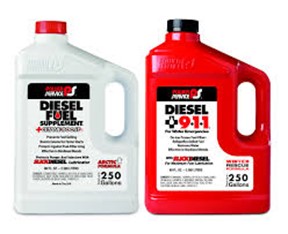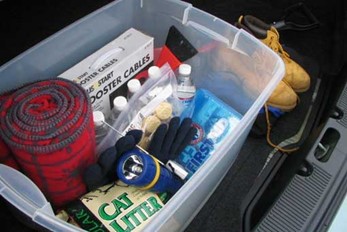Monday, September 22, is the First Day of Fall. Now is the time to start preparing your operation for the cold weather ahead. Your drivers should understand what is required to keep their trucks running during the winter months.
Fuel Additive Use During Cold Weather Conditions
Fuel additives that prevent gelling should be added anytime the ambient temperature falls below 32°F. Power Service and Penray are popular manufacturers of fuel additives, and both companies have products available through Navistar and Idealease locations.
Power Service
-
The “Red Bottle” (Power Service 911) should be used only when
the fuel in a unit has already gelled.
-
911 is not to be used as a regular additive to prevent gelling.
-
The “White Bottle” (Power Service Diesel Fuel Supplement + Cetane Boost) should be added at each fill when the ambient temperature is below 30°F.
-
This is the additive recommended for regular use during the winter months.
Penray
-
Winter Thaw Emergency Diesel Fuel Supplement: Dissolves already gelled fuel quickly and reduces clogging of fuel filters. Prevents ice crystal buildup in fuel lines and filters by dispersing moisture. Eliminates hard starting, pounding, and excessive smoking, while improving combustion. 100% compatible with low sulfur fuel and blends.
-
Winter Pow-R Plus Diesel Fuel Supplement: ULSD compliant. Prevents gelling of diesel fuel and ice crystal formation. Reduces cold filter plug point by up to 30°F. Enhances cetane, improves fuel economy, and utilizes HAFI® technology. Improves cold-weather starting, stabilizes fuel, prevents corrosion, reduces emissions, and improves lubricity.
How to Make a Cold Weather Survival Kit
Every driver should carry a Winter Survival Kit in their truck. In an emergency, it could save your life. Recommended items include:
-
Shovel
-
Windshield scraper and small broom
-
Flashlight with extra batteries
-
Battery-powered radio
-
Water
-
Snack food (energy bars, raisins, mini candy bars)
-
Matches and small candles
-
Disposable hand/foot warmers
-
Extra hats, socks, and mittens
-
First-aid kit with pocket knife
-
Necessary medications
-
Blankets or sleeping bag
-
Tow chain or rope
-
Road salt, sand, or cat litter for traction
-
Booster cables
-
Fluorescent distress flag and whistle
-
Cell phone adapter for vehicle lighter and/or extra battery supply
Driving a Truck Is a Dangerous Job
When people think of dangerous jobs, police officers, firefighters, and construction workers often come to mind. Tractor-trailer truck drivers may not, but Bureau of Labor Statistics data show that driving a truck is risky in unexpected ways.
For example:
-
One out of every seven American workers killed on the job is a tractor-trailer truck driver.
-
In 2022, 625 tractor-trailer truck drivers were killed while working.
-
Of these fatalities, 78% were caused by transportation incidents.
Heavy and tractor-trailer truck drivers also experience the highest number of nonfatal injuries and illnesses requiring days off across all occupations. They rank 6th among the top occupations with the highest incidence rates of nonfatal injuries and illnesses involving time away from work—following police officers and sheriffs, firefighters, highway maintenance workers, correctional officers, and nursing assistants. Nearly one out of every 20 workplace injury/illness cases nationwide that required time off involved a truck driver.
In fact, tractor-trailer truck drivers are three times more likely than the typical American worker to sustain an injury or illness requiring time off. The most common causes are slips, trips, and falls, followed by overexertion—such as pushing and pulling containers, lifting heavy items during loading/unloading, and repeatedly getting in and out of the vehicle.
Drivers also rank third among all occupations for musculoskeletal disorders (injuries to muscles, nerves, tendons, joints, cartilage, or spinal discs) that required time away from work. Causes include overexertion, repetitive climbing in and out of the truck, assisting with loading/unloading, and prolonged sitting or maintaining poor posture while driving.
When truck drivers are injured, recovery times are longer compared to other workers. Half of all truck drivers who miss work after an incident require at least 20 days off before returning, compared to just nine days for the average worker. Additionally, 42% of injured truck drivers miss more than a month of work.
The Federal Motor Carrier Safety Administration (FMCSA) is tasked with reducing the number and severity of crashes involving large commercial trucks and buses. In addition to regulatory oversight, FMCSA provides online safety resources through its program “Our Roads, Our Responsibility,” which promotes safe roadway sharing among all users, including bicyclists and pedestrians.
More information about preventing musculoskeletal disorders is available from OSHA, while additional data on work-related fatalities, injuries, and illnesses can be found on the Bureau of Labor Statistics website.
We hope this information helps employers improve conditions for tractor-trailer drivers and empowers workers with knowledge of the hazards they may face.
If you have questions or need additional information about this data, please contact us.
Sean Smith and Patrick Harris are economists at the Bureau of Labor Statistics. BLS employees Nicole Nestoriak and Erin Huband also contributed to this post.









